Lei Tian
Research and Experimental Validation for 3GPP ISAC Channel Modeling Standardization
Apr 14, 2025Abstract:Integrated Sensing and Communication (ISAC) is considered a key technology in 6G networks. An accurate sensing channel model is crucial for the design and sensing performance evaluation of ISAC systems. The widely used Geometry-Based Stochastic Model (GBSM), typically applied in standardized channel modeling, mainly focuses on the statistical fading characteristics of the channel. However, it fails to capture the characteristics of targets in ISAC systems, such as their positions and velocities, as well as the impact of the targets on the background. To address this issue, this paper proposes an extended GBSM (E-GBSM) sensing channel model that incorporates newly discovered channel characteristics into a unified modeling framework. In this framework, the sensing channel is divided into target and background channels. For the target channel, the model introduces a concatenated modeling approach, while for the background channel, a parameter called the power control factor is introduced to assess impact of the target on the background channel, making the modeling framework applicable to both mono-static and bi-static sensing modes. To validate the proposed model's effectiveness, measurements of target and background channels are conducted in both indoor and outdoor scenarios, covering various sensing targets such as metal plates, reconfigurable intelligent surfaces, human bodies, UAVs, and vehicles. The experimental results provide important theoretical support and empirical data for the standardization of ISAC channel modeling.
A Survey of New Mid-Band/FR3 for 6G: Channel Measurement, Characterization and Modeling in Outdoor Environment
Apr 09, 2025Abstract:The new mid-band (6-24 GHz) has attracted significant attention from both academia and industry, which is the spectrum with continuous bandwidth that combines the coverage benefits of low frequency with the capacity advantages of high frequency. Since outdoor environments represent the primary application scenario for mobile communications, this paper presents the first comprehensive review and summary of multi-scenario and multi-frequency channel characteristics based on extensive outdoor new mid-band channel measurement data, including UMa, UMi, and O2I. Specifically, a survey of the progress of the channel characteristics is presented, such as path loss, delay spread, angular spread, channel sparsity, capacity and near-field spatial non-stationary characteristics. Then, considering that satellite communication will be an important component of future communication systems, we examine the impact of clutter loss in air-ground communications. Our analysis of the frequency dependence of mid-band clutter loss suggests that its impact is not significant. Additionally, given that penetration loss is frequency-dependent, we summarize its variation within the FR3 band. Based on experimental results, comparisons with the standard model reveal that while the 3GPP TR 38.901 model remains a useful reference for penetration loss in wood and glass, it shows significant deviations for concrete and glass, indicating the need for further refinement. In summary, the findings of this survey provide both empirical data and theoretical support for the deployment of mid-band in future communication systems, as well as guidance for optimizing mid-band base station deployment in the outdoor environment. This survey offers the reference for improving standard models and advancing channel modeling.
A Novel Environment Object Modeling Method for Vehicular ISAC Scenarios
Mar 15, 2025Abstract:Integrated Sensing and Communication (ISAC), as a fundamental technology of 6G, empowers Vehicle-to-Everything (V2X) systems with enhanced sensing capabilities. One of its promising applications is the reliance on constructed maps for vehicle positioning. Traditional positioning methods primarily rely on Line-of-Sight (LOS), but in urban vehicular scenarios, obstructions often result in predominantly Non-Line-of-Sight (NLOS) conditions. Existing research indicates that NLOS paths, characterized by one-bounce reflection on building walls with determined delay and angle, can support sensing and positioning. However, experimental validation remains insufficient. To address this gap, channel measurements are conducted in an urban street to explore the existence of strong reflected paths in the presence of a vehicle target. The results show significant power contribution from NLOS paths, with large Environmental Objects (EOs) playing a key role in shaping NLOS propagation. Then, a novel model for EO reflection is proposed to extend the Geometry-Based Stochastic Model (GBSM) for ISAC channel standardization. Simulation results validate the model's ability to capture EO's power and position characteristics, showing that higher EO-reflected power and closer distance to Rx reduce Delay Spread (DS), which is more favorable for positioning. This model provides theoretical guidance and empirical support for ISAC positioning algorithms and system design in vehicular scenarios.
Cascaded channel modeling and experimental validation for RIS assisted communication system
Dec 10, 2024Abstract:Reconfigurable Intelligent Surface (RIS) is considered as a promising technology for 6G due to its ability to actively modify the electromagnetic propagation environment. Accurate channel modeling is essential for the design and evaluation of RIS assisted communication systems. Most current research models the RIS channel as a cascade of Tx-RIS and RIS-Rx sub-channels. However, most validation efforts regarding this assumption focus on large-scale path loss. To further explore this, in this paper, we derive and extend a convolution expression of RIS cascaded channel model based on the previously proposed Geometry-based Stochastic Model (GBSM)-based RIS cascaded channels. This model follows the 3GPP standard framework and leverages parameters such as angles, delays, and path powers defined in the GBSM model to more accurately reflect the smallscale characteristics of RIS multipath cascades. To verify the accuracy of this model, we conduct measurements of the TxRIS-Rx channel, Tx-RIS, and RIS-Rx sub-channels in a factory environment at 6.9 GHz, using the measured data to demonstrate the models validity and applicability in real-world scenarios. Validation with measured data shows that the proposed model accurately describes the characteristics of the RIS cascaded channel in terms of delay, angle, and power in complex multipath environments, providing important references for the design and deployment of RIS systems.
BUPTCMCC-6G-CMG+: A GBSM-Based ISAC Channel Model Simulator
Sep 22, 2024



Abstract:Integrated Sensing and Communication (ISAC) is one of the key technologies in 6G, and related research and standardization efforts are progressing vigorously. Wireless channel simulation is the cornerstone for the evaluation and optimization of wireless communication technologies. This paper proposes a design and implementation method for an ISAC channel simulation based on a Geometry-Based Stochastic Model (GBSM) simulation framework. First, we introduce the progress of 3GPP ISAC channel standardization and the key topics of discussion. Second, addressing the current lack of a standardized ISAC channel simulation framework, we propose a cascaded ISAC channel simulation framework based on GBSM, leveraging our team's related measurements, analyses, and proposal results. Based on this framework, we develop and design the ISAC channel simulator BUPTCMCC-6G-CMG+. Finally, we analyze and validate the simulation platform results, and provide some prospects for future ISAC testing research combined with channel simulators.
Self-Supervised Elimination of Non-Independent Noise in Hyperspectral Imaging
Sep 16, 2024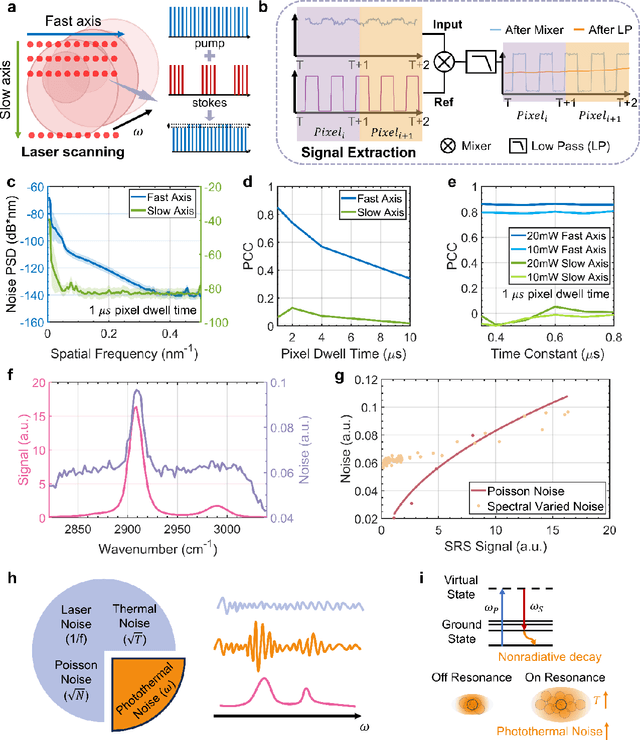
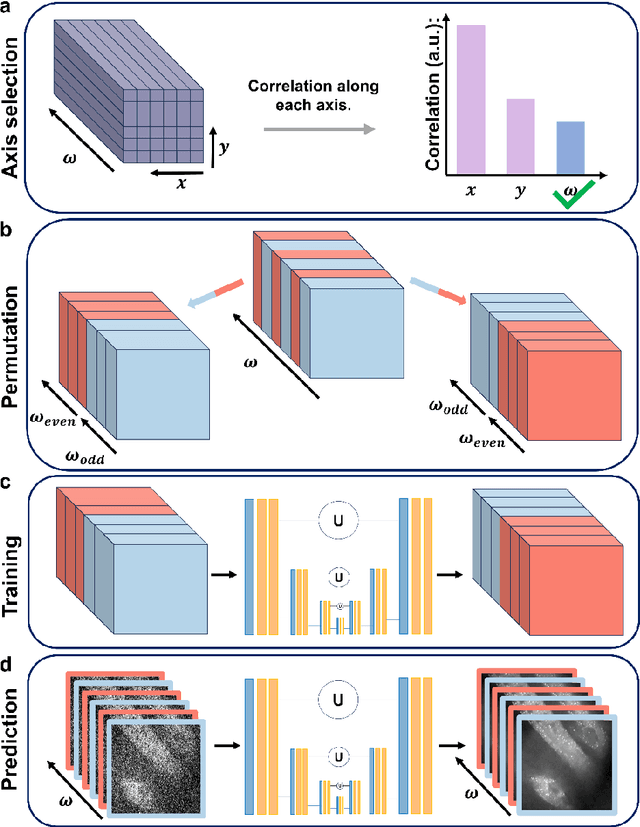
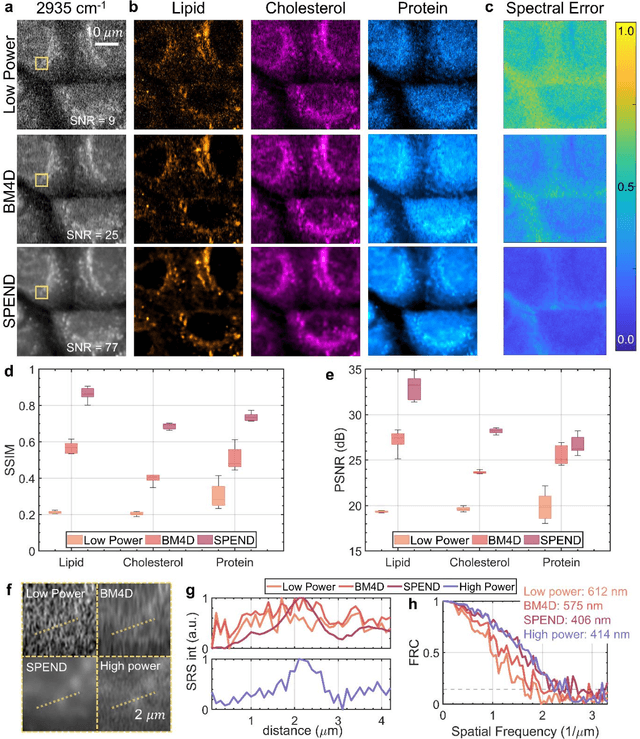
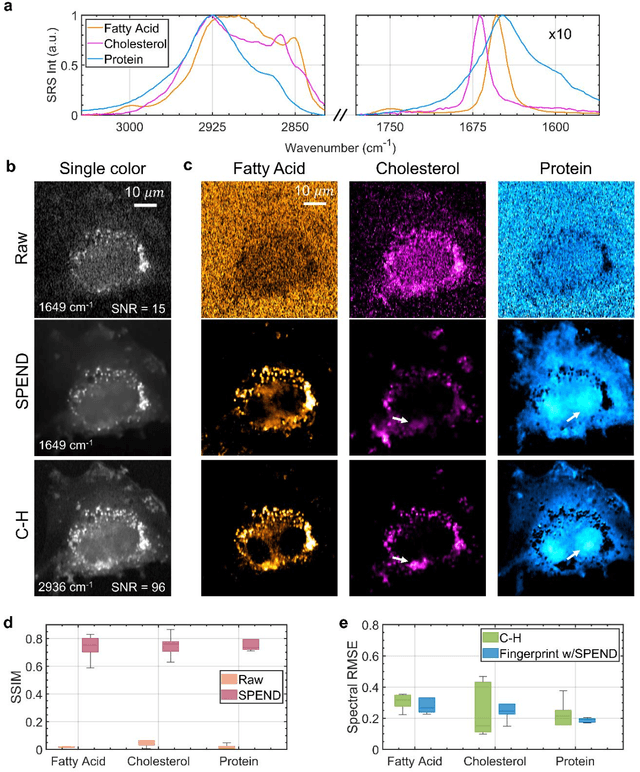
Abstract:Hyperspectral imaging has been widely used for spectral and spatial identification of target molecules, yet often contaminated by sophisticated noise. Current denoising methods generally rely on independent and identically distributed noise statistics, showing corrupted performance for non-independent noise removal. Here, we demonstrate Self-supervised PErmutation Noise2noise Denoising (SPEND), a deep learning denoising architecture tailor-made for removing non-independent noise from a single hyperspectral image stack. We utilize hyperspectral stimulated Raman scattering and mid-infrared photothermal microscopy as the testbeds, where the noise is spatially correlated and spectrally varied. Based on single hyperspectral images, SPEND permutates odd and even spectral frames to generate two stacks with identical noise properties, and uses the pairs for efficient self-supervised noise-to-noise training. SPEND achieved an 8-fold signal-to-noise improvement without having access to the ground truth data. SPEND enabled accurate mapping of low concentration biomolecules in both fingerprint and silent regions, demonstrating its robustness in sophisticated cellular environments.
Empirical Studies of Propagation Characteristics and Modeling Based on XL-MIMO Channel Measurement: From Far-Field to Near-Field
Apr 26, 2024Abstract:In the sixth-generation (6G), the extremely large-scale multiple-input-multiple-output (XL-MIMO) is considered a promising enabling technology. With the further expansion of array element number and frequency bands, near-field effects will be more likely to occur in 6G communication systems. The near-field radio communications (NFRC) will become crucial in 6G communication systems. It is known that the channel research is very important for the development and performance evaluation of the communication systems. In this paper, we will systematically investigate the channel measurements and modeling for the emerging NFRC. First, the principle design of massive MIMO channel measurement platform are solved. Second, an indoor XL-MIMO channel measurement campaign with 1600 array elements is conducted, and the channel characteristics are extracted and validated in the near-field region. Then, the outdoor XL-MIMO channel measurement campaign with 320 array elements is conducted, and the channel characteristics are extracted and modeled from near-field to far-field (NF-FF) region. The spatial non-stationary characteristics of angular spread at the transmitting end are more important in modeling. We hope that this work will give some reference to the near-field and far-field research for 6G.
Wide-Field, High-Resolution Reconstruction in Computational Multi-Aperture Miniscope Using a Fourier Neural Network
Mar 11, 2024Abstract:Traditional fluorescence microscopy is constrained by inherent trade-offs among resolution, field-of-view, and system complexity. To navigate these challenges, we introduce a simple and low-cost computational multi-aperture miniature microscope, utilizing a microlens array for single-shot wide-field, high-resolution imaging. Addressing the challenges posed by extensive view multiplexing and non-local, shift-variant aberrations in this device, we present SV-FourierNet, a novel multi-channel Fourier neural network. SV-FourierNet facilitates high-resolution image reconstruction across the entire imaging field through its learned global receptive field. We establish a close relationship between the physical spatially-varying point-spread functions and the network's learned effective receptive field. This ensures that SV-FourierNet has effectively encapsulated the spatially-varying aberrations in our system, and learned a physically meaningful function for image reconstruction. Training of SV-FourierNet is conducted entirely on a physics-based simulator. We showcase wide-field, high-resolution video reconstructions on colonies of freely moving C. elegans and imaging of a mouse brain section. Our computational multi-aperture miniature microscope, augmented with SV-FourierNet, represents a major advancement in computational microscopy and may find broad applications in biomedical research and other fields requiring compact microscopy solutions.
UniVG: Towards UNIfied-modal Video Generation
Jan 17, 2024Abstract:Diffusion based video generation has received extensive attention and achieved considerable success within both the academic and industrial communities. However, current efforts are mainly concentrated on single-objective or single-task video generation, such as generation driven by text, by image, or by a combination of text and image. This cannot fully meet the needs of real-world application scenarios, as users are likely to input images and text conditions in a flexible manner, either individually or in combination. To address this, we propose a Unified-modal Video Genearation system that is capable of handling multiple video generation tasks across text and image modalities. To this end, we revisit the various video generation tasks within our system from the perspective of generative freedom, and classify them into high-freedom and low-freedom video generation categories. For high-freedom video generation, we employ Multi-condition Cross Attention to generate videos that align with the semantics of the input images or text. For low-freedom video generation, we introduce Biased Gaussian Noise to replace the pure random Gaussian Noise, which helps to better preserve the content of the input conditions. Our method achieves the lowest Fr\'echet Video Distance (FVD) on the public academic benchmark MSR-VTT, surpasses the current open-source methods in human evaluations, and is on par with the current close-source method Gen2. For more samples, visit https://univg-baidu.github.io.
HiCAST: Highly Customized Arbitrary Style Transfer with Adapter Enhanced Diffusion Models
Jan 11, 2024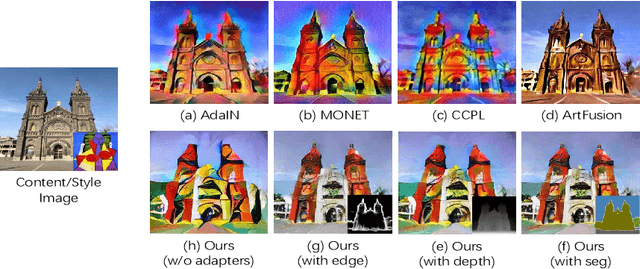

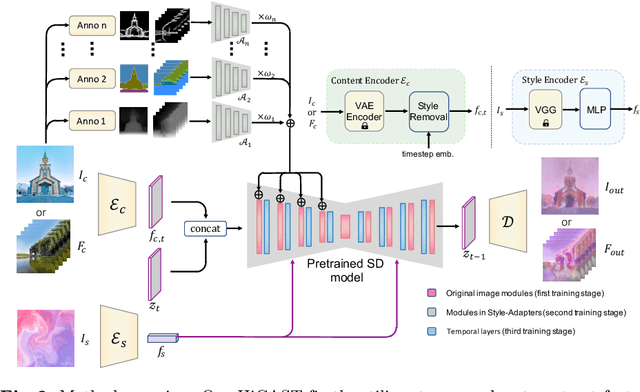
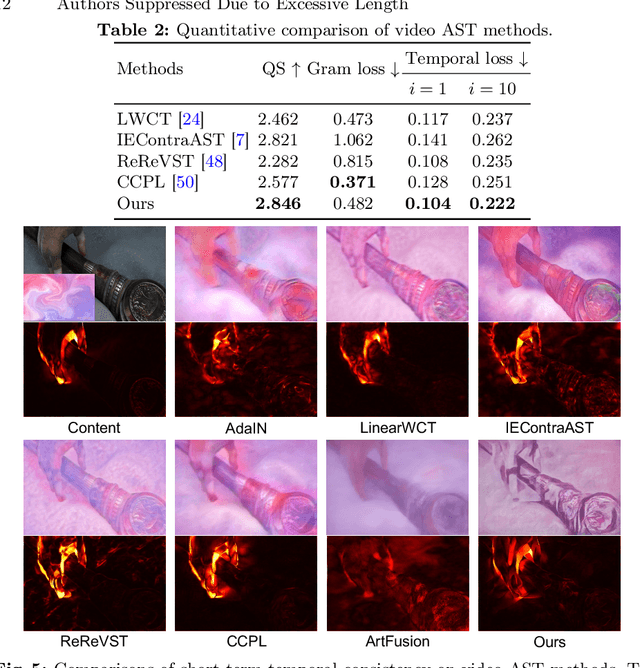
Abstract:The goal of Arbitrary Style Transfer (AST) is injecting the artistic features of a style reference into a given image/video. Existing methods usually focus on pursuing the balance between style and content, whereas ignoring the significant demand for flexible and customized stylization results and thereby limiting their practical application. To address this critical issue, a novel AST approach namely HiCAST is proposed, which is capable of explicitly customizing the stylization results according to various source of semantic clues. In the specific, our model is constructed based on Latent Diffusion Model (LDM) and elaborately designed to absorb content and style instance as conditions of LDM. It is characterized by introducing of \textit{Style Adapter}, which allows user to flexibly manipulate the output results by aligning multi-level style information and intrinsic knowledge in LDM. Lastly, we further extend our model to perform video AST. A novel learning objective is leveraged for video diffusion model training, which significantly improve cross-frame temporal consistency in the premise of maintaining stylization strength. Qualitative and quantitative comparisons as well as comprehensive user studies demonstrate that our HiCAST outperforms the existing SoTA methods in generating visually plausible stylization results.
 Add to Chrome
Add to Chrome Add to Firefox
Add to Firefox Add to Edge
Add to Edge